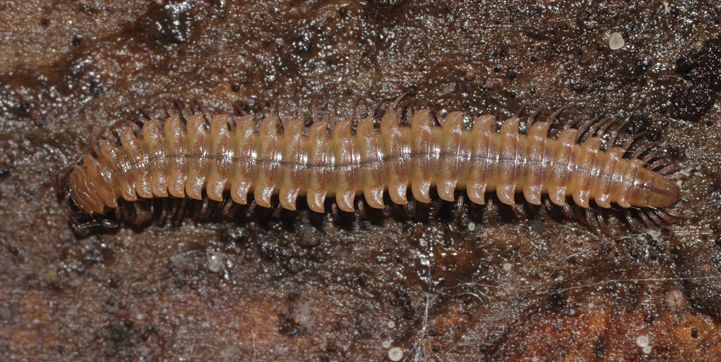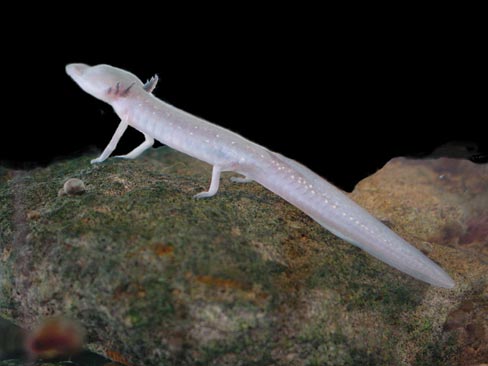|
Lipseuma Josianae
''Lipseuma'' is a genus of millipedes in the family Kashmireumatidae. This genus contains only two species, the type species '' L. josianae'' and its close relative '' L. bernardi''. Both species are troglobites found in caves in China. Discovery This genus and its two species were first described in 2006 by the biologist Sergei Golovatch of the Russian Academy of Sciences and two biologists at the Muséum National d’Histoire Naturelle in France, Jean-Jacques Geoffroy and Jean-Paul Mauriès. The original descriptions are based on specimens collected in 1999 by the biospeleologists Josiane and Bernard Lips, for whom the genus and its two species are named. The ''L. josianae'' holotype (a male) and seven paratypes (two males, one female, and four juveniles) were found in the Chuan Dong Zi cave in Banqiao in Hubei province in China. The ''L. bernardi'' holotype (a male) and two paratypes (one incomplete male and one subadult male) were found in the Three Eyes cave in Xinlong coun ... [...More Info...] [...Related Items...] OR: [Wikipedia] [Google] [Baidu] |
Genus
Genus ( plural genera ) is a taxonomic rank used in the biological classification of extant taxon, living and fossil organisms as well as Virus classification#ICTV classification, viruses. In the hierarchy of biological classification, genus comes above species and below family (taxonomy), family. In binomial nomenclature, the genus name forms the first part of the binomial species name for each species within the genus. :E.g. ''Panthera leo'' (lion) and ''Panthera onca'' (jaguar) are two species within the genus ''Panthera''. ''Panthera'' is a genus within the family Felidae. The composition of a genus is determined by taxonomy (biology), taxonomists. The standards for genus classification are not strictly codified, so different authorities often produce different classifications for genera. There are some general practices used, however, including the idea that a newly defined genus should fulfill these three criteria to be descriptively useful: # monophyly – all descendants ... [...More Info...] [...Related Items...] OR: [Wikipedia] [Google] [Baidu] |
Paratype
In zoology and botany, a paratype is a specimen of an organism that helps define what the scientific name of a species and other taxon actually represents, but it is not the holotype (and in botany is also neither an isotype nor a syntype). Often there is more than one paratype. Paratypes are usually held in museum research collections. The exact meaning of the term ''paratype'' when it is used in zoology is not the same as the meaning when it is used in botany. In both cases however, this term is used in conjunction with ''holotype''. Zoology In zoological nomenclature, a paratype is officially defined as "Each specimen of a type series other than the holotype.", ''International Code of Zoological Nomenclature'' In turn, this definition relies on the definition of a "type series". A type series is the material (specimens of organisms) that was cited in the original publication of the new species or subspecies, and was not excluded from being type material by the author (th ... [...More Info...] [...Related Items...] OR: [Wikipedia] [Google] [Baidu] |
Gonopod
Gonopods are specialized appendages of various arthropods used in reproduction or egg-laying. In males, they facilitate the transfer of sperm from male to female during mating, and thus are a type of intromittent organ. In crustaceans and millipedes, gonopods are modified walking or swimming legs. Gonopods may be highly decorated with elaborate structures which may play roles in sperm competition, and can be used to differentiate and identify closely related species. Gonopods generally occur in one or more pairs, as opposed to the single (un-paired) reproductive organs such as the aedeagus of insects or the Opiliones penis, penis of harvestmen. Insects In insects, gonopods are appendages of the genital segment that may be used in insemination, or that comprise the egg-laying apparatus. Crustaceans In male decapoda, decapod crustaceans, gonopods are modified swimming appendages (pleopods). The anterior two pair of pleopods in males are modified for sperm transferring, with dif ... [...More Info...] [...Related Items...] OR: [Wikipedia] [Google] [Baidu] |
Chordeumatida
Chordeumatida (from the Greek word for "sausage") is a large order of millipedes containing some 1200 species with a nearly worldwide distribution. Also known as "sausage millipedes," they possess around 30 body segments behind the head (including the telson) as adults and reach about in length. Description Chordeumatidans are relatively short-bodied, with only 26 to 32 body segments (including the telson) behind the head. They range in length from . A key feature is the presence of 6 large bristles (setae) on the dorsal surface of each body segment. The first segment ( collum) is relatively narrow, giving the appearance of a distinct "neck" in many species. The body tapers towards the rear, and the rearmost tip (telson) contains silk-producing organs (spinnerets). A dorsal groove runs down the length of the body, and some species possess paranota, lateral extensions of the exoskeleton. Paranota are also found in some other millipedes, notably Polydesmida, from which Chordeumat ... [...More Info...] [...Related Items...] OR: [Wikipedia] [Google] [Baidu] |
Order (biology)
Order ( la, wikt:ordo#Latin, ordo) is one of the eight major hierarchical taxonomic ranks in Linnaean taxonomy. It is classified between Family_(biology), family and Class_(biology), class. In biological classification, the order is a taxonomic rank used in the classification of organisms and recognized by the nomenclature codes. An immediately higher rank, superorder, is sometimes added directly above order, with suborder directly beneath order. An order can also be defined as a group of related families. What does and does not belong to each order is determined by a taxonomist, as is whether a particular order should be recognized at all. Often there is no exact agreement, with different taxonomists each taking a different position. There are no hard rules that a taxonomist needs to follow in describing or recognizing an order. Some taxa are accepted almost universally, while others are recognized only rarely. The name of an order is usually written with a capital letter. Fo ... [...More Info...] [...Related Items...] OR: [Wikipedia] [Google] [Baidu] |
Telson
The telson () is the posterior-most division of the body of an arthropod. Depending on the definition, the telson is either considered to be the final segment of the arthropod body, or an additional division that is not a true segment on account of not arising in the embryo from teloblast areas as other segments. It never carries any appendages, but a forked "tail" called the caudal furca may be present. The shape and composition of the telson differs between arthropod groups. Crustaceans In lobsters, shrimp and other decapods, the telson, along with the uropods, forms the tail fan. This is used as a paddle in the caridoid escape reaction ("lobstering"), whereby an alarmed animal rapidly flexes its tail, causing it to dart backwards. Krill can reach speeds of over 60 cm per second by this means. The trigger time to optical stimulus is, in spite of the low temperatures, only 55 milliseconds. In the Isopoda and Tanaidacea (superorder Peracarida), the last abdominal b ... [...More Info...] [...Related Items...] OR: [Wikipedia] [Google] [Baidu] |
Troglomorphism
Troglomorphism is the morphological adaptation of an animal to living in the constant darkness of caves, characterised by features such as loss of pigment, reduced eyesight or blindness, and frequently with attenuated bodies and/or appendages. The terms troglobitic, stygobitic, stygofauna, troglofauna, and hypogean or hypogeic, are often used for cave-dwelling organisms. A 2012 study by a team from the National University of Singapore found that reductive changes in freshwater cave crabs evolved at the same rate as constructive changes. This shows that both selection and evolution have a role in advancing reductive changes (e.g smaller eyes) and constructive changes (e.g larger claws), making troglomorphic adaptations subject to strong factors that affect an organism's morphology. Troglomorphism occurs in molluscs, velvet worms, arachnids, myriapods, crustaceans, insects, fish, amphibians (notably cave salamanders) and reptiles. To date no mammals or birds have been found to live ... [...More Info...] [...Related Items...] OR: [Wikipedia] [Google] [Baidu] |
Paris
Paris () is the capital and most populous city of France, with an estimated population of 2,165,423 residents in 2019 in an area of more than 105 km² (41 sq mi), making it the 30th most densely populated city in the world in 2020. Since the 17th century, Paris has been one of the world's major centres of finance, diplomacy, commerce, fashion, gastronomy, and science. For its leading role in the arts and sciences, as well as its very early system of street lighting, in the 19th century it became known as "the City of Light". Like London, prior to the Second World War, it was also sometimes called the capital of the world. The City of Paris is the centre of the Île-de-France region, or Paris Region, with an estimated population of 12,262,544 in 2019, or about 19% of the population of France, making the region France's primate city. The Paris Region had a GDP of €739 billion ($743 billion) in 2019, which is the highest in Europe. According to the Economist Intelli ... [...More Info...] [...Related Items...] OR: [Wikipedia] [Google] [Baidu] |
Type (biology)
In biology, a type is a particular specimen (or in some cases a group of specimens) of an organism to which the scientific name of that organism is formally attached. In other words, a type is an example that serves to anchor or centralizes the defining features of that particular taxon. In older usage (pre-1900 in botany), a type was a taxon rather than a specimen. A taxon is a scientifically named grouping of organisms with other like organisms, a set that includes some organisms and excludes others, based on a detailed published description (for example a species description) and on the provision of type material, which is usually available to scientists for examination in a major museum research collection, or similar institution. Type specimen According to a precise set of rules laid down in the International Code of Zoological Nomenclature (ICZN) and the International Code of Nomenclature for algae, fungi, and plants (ICN), the scientific name of every taxon is almost al ... [...More Info...] [...Related Items...] OR: [Wikipedia] [Google] [Baidu] |
Sichuan
Sichuan (; zh, c=, labels=no, ; zh, p=Sìchuān; alternatively romanized as Szechuan or Szechwan; formerly also referred to as "West China" or "Western China" by Protestant missions) is a province in Southwest China occupying most of the Sichuan Basin and the easternmost part of the Tibetan Plateau between the Jinsha River on the west, the Daba Mountains in the north and the Yungui Plateau to the south. Sichuan's capital city is Chengdu. The population of Sichuan stands at 83 million. Sichuan neighbors Qinghai to the northwest, Gansu to the north, Shaanxi to the northeast, Chongqing to the east, Guizhou to the southeast, Yunnan to the south, and the Tibet Autonomous Region to the west. In antiquity, Sichuan was the home of the ancient states of Ba and Shu. Their conquest by Qin strengthened it and paved the way for Qin Shi Huang's unification of China under the Qin dynasty. During the Three Kingdoms era, Liu Bei's state of Shu was based in Sichuan. The ... [...More Info...] [...Related Items...] OR: [Wikipedia] [Google] [Baidu] |








.jpg)